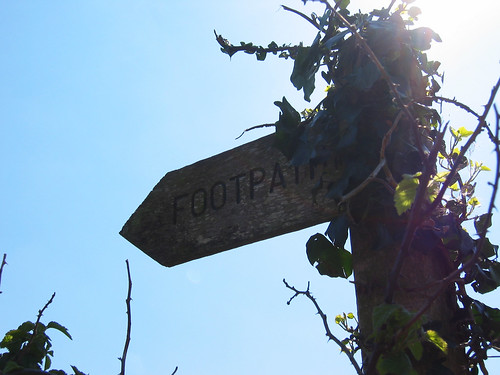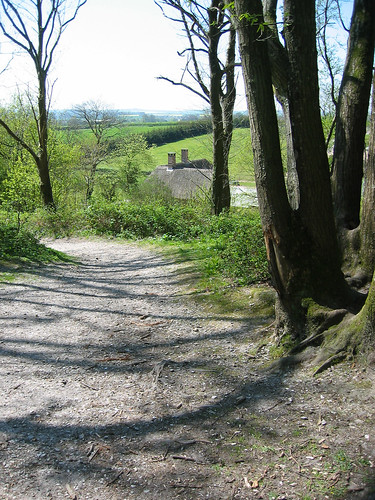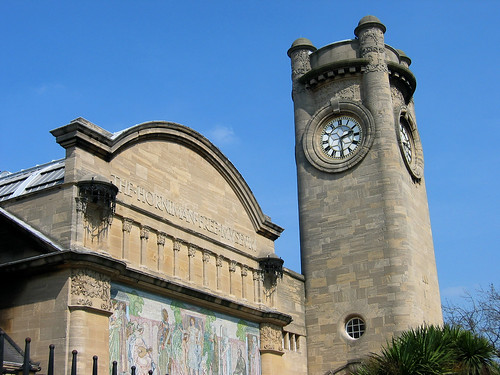1 Literature drove me to the British Isles on my first trip eleven years ago when I moved there for a time, fresh out of college--specifically literature of London, from the pens of Charles Dickens, Iris Murdoch, Sir Arthur Conan Doyle, and others. I wanted to see--and more, know--the place that so enchanted them. And literature has remained a driving force behind my English travel since, this time taking me to Dorset to see the country that inspired so much of Thomas Hardy's best writing.
Stacey and I spent a day and a half in Dorchester, visiting the Dorset County Museum, where we were reminded that Hardy's often-difficult mother raised him on a diet of stories "seamed with fatalism." Hardy's heroines, from Tess to Eustacia Yeobright, wouldn't be surprised. The town, which Hardy renamed Casterbridge, while in no sense preserved in amber, retains enough of a feel of the village Hardy would have known that it's no stretch to imagine his characters walking its streets.

The hike between the Hardy family's cottage and the town--which as a young man Hardy made every workday--through fields and woodlands along the River Frome, is sufficiently rural to allow a hiker to pretend to be, for a while, in Hardy's time.

There are points on the final approach to Dorchester where the only visible signs of the city, raised slightly above the floodplain and silhouetted against a wide, open sky, are buildings Hardy would have recognized. Lambs bleat in the pasture, crows proclaim from the trees, baby ducks quack worriedly on the Frome, and all that is required to let a century slip away is imagining thin columns of smoke rising from chimneys. For Hardy fans, that walk alone is worth the trip.

2 On the walk between Dorchester and the Hardy family cottage in Lower Bockhampton, we crossed a small stone bridge, on which was the following sign:

In case you can't read it in the photo, here's what it says:
Take Notice that this Bridge (which is a County Bridge) is insufficient to carry weights beyond the ordinary traffic of the district; and that the owners and persons in charge of Locomotive Traction Engines and other ponderous Carriages are warned against using the Bridge for the passage of any such Engine or Carriage.
E. Archdall Frooks
Clerk of the County Council of Dorset
3 A few nights later, walking through Russell Square, in the heart of Bloomsbury, I saw a young man on a bench reading The Communist Manifesto. Such a young man has surely been there, in more-or-less down-at heel versions of the prevailing fashions, since soon after the days when Marx himself frequented the British Library.
4 When I lived in London, I worked at a branch of the bookstore chain Books, Etc. (which is now owned by Borders). My shop was in Bayswater, in the old Whiteleys department store, which had been turned into a shopping mall in 1989. William Whiteley's first store, opened in Westbourne Grove in 1863, was a great success, claiming to provide "everything from a pin to an elephant," but it burned in 1897 and the new flagship in Bayswater was built in 1911.
While I worked there, I heard the story, likely as not to be apocryphal, that the architect who designed the store committed suicide after realizing that he had mis-designed the grand central staircases: they led patrons the wrong way, pushing them out of the center of the store rather than back in for more shopping. But it wasn't until I read The Book of Lists: London (2006) on this trip that I learned the fate of Whiteley himself. According to The Book of Lists:
Whiteley made many enemies and, in 1907, was shot dead in his private office by a man claiming to be his illegitimate son.Despite Whiteley's untimely demise and the conversion of the store into a mall, Whiteleys of Bayswater can still give you a sense of early twentieth-century department stores at their most ornate. If Harrods and Selfridges are too crowded for you to bear, Whiteleys will do just fine.
5 Finally, to close a fortnight of London blogging, I'll return to the Horniman Museum--whose founder, perhaps rightly distrusting the philanthropy of future generations, set in its stone facade, alongside the museum's name, the words "Free Museum."

Stacey and I and our English friends spent a wonderful day of picnicking, juggling, sketching, and drinking wine in the pleasant, hilly park that adjoins the museum. It wasn't until our next visit there, a week later, to check out the museum, that I spotted a sundial whose inscription read:
The hours run like madOur vacation, too short, too busy, was winding down as I read that. With friends and places as with books, there's never enough time.
E'en as men might.
No comments:
Post a Comment